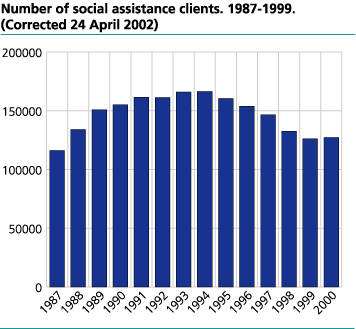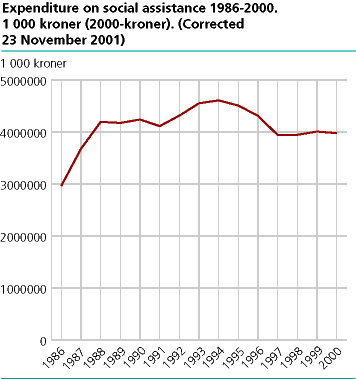Content
Published:
This is an archived release.
Same number received social assistance
After four-year whit decline in the number of social assistance recipients, year 2000 shows a small increase. Nevertheless the increase in out paying has been considerable. A total of NOK 4,0 billion was paid out in social assistance last year.
After a stabile decline in the number of social assistance recipients since the top year 1994 with 166.000 recipients, it now seems to have been an equalisation. The increase has gone from 126.200 recipients in 1999, to 127.200 recipients last year. 45.200 of these social assistance recipients were new recipients during the year. This is the same tendency as in 1999.
The number of repeat recipients of social assistance has also decreased in the period of 1994 to 1999. Last year shows stability in the number of repeat recipients of social assistance. While 89.000 persons in 1998 had received social assistance in 1997, 81 000 recipients in 1999 and 2000 had received social assistance the previous year.
Increased benefit
Altogether NOK 4,0 billion in social assistance was paid out last year. This is an increase of about NOK 62 million, or 1,6 per cent compared with the year before (calculated in constant prices). Average annual social assistance benefits per recipient last year were NOK 29.000, or just over NOK 6.300 per month with assistance. This is approximately the same level as in 1999.
Highest benefit level in Oslo
The regional differences regarding the level of average annual benefit amounts are also large. Oslo has clearly the highest level of benefit with an average of NOK 44.000 per case. This is nearly NOK 12.000 more than the next county, Akershus, with NOK 32.000 per case. Once again, Finnmark had the lowest average benefit level in 1999, with NOK 19.400 per case.
There is a close correlation between the size of the municipality and benefit level. The level of the benefit is highest in the most populated municipalities. While the average benefit per case in municipalities with more than 50.000 residents was NOK 36.500 in 2000, the corresponding number for municipalities with under 5.000 inhabitants was NOK 18.800. Social assistance is meant to cover housing costs of clients. High housing costs in densely populated municipalities are the reason for higher levels of social assistance in these municipalities.
Decline among long-term recipients
From 1998 to 1999 the number of recipients that received social service for six or more months went down from about 38 per cent of all recipients in 1998 to 37 per cent of all recipients in 1999. Even among the long-term users of social assistance has the exposition in 2000 flattening out after a number of years with decrease. In 1996 more than 41 per cent of all recipients received social assistance for six or more months. The number of recipients who received benefits the entire year decreased slightly last year. In 1999 just over 11.200 social assistance recipients were clients the entire year, against 12.100 in 2000. This is still a little bit lower than the years before. Last year the average benefit time for all recipients was 5 months.
Few changes in the age mix of the social assistance recipients
The largest reduction of social assistance recipients has been found the latest years among the recipients between 20 and 24 years. The number for 2000 shows that this decrease has stagnated and one can find a small increase to 21.000 recipients in this group. This is equivalent to about eight per cent of the population between 20 and 24 years of age. The corresponding figure from 1994 was 11 per cent. Last year about 22.800 clients were between 20 and 24.
If one sees the social assistance recipients per 1.000 inhabitants for the different age groups, it is the group between 20 and 24 years that have the biggest share whit of 74 recipients per 1.000. Also in the age group 25 to 29 the share of recipients per 1.000 is high. The share is 55 per 1.000 inhabitants.
Small increase in recipients who list pension as their main source of income
About 36 per cent of the social assistance recipients in 2000 list pension as their main source of income. For 1999 the corresponding number was 34 per cent. The number of social assistance recipients who list income from employment as their main source of income has been just over 12 per cent for the last three years. Before that the number had been stabile at 11 per cent since 1993.
On the other hand, it looks as though clients are becoming increasingly more dependent on social assistance as a source of income; the number of social assistance recipients that listed social assistance as their main source of income has climbed every year since 1988. In 1988 this applied to 27 per cent of clients, against 43 per cent in 1995, 46 per cent in 1999 and 45 per cent in 2000.
Finnmark has the highest share of social assistance cases
There are huge differences among the counties in the number of social assistance cases in proportion to the population. Last year, 19.900 persons received social assistance in Oslo. In 1999, Oslo had 41 cases of social assistance per 1.000 inhabitants; in 2000 the number fell to 39 cases. Largest increase in share of cases from 1999 had Østfold whit 40 cases per 1.000 inhabitants in 2000 towards 37 in 1999. Vestfold shows a decrease between 1999 and 2000, from a share of 34 cases in 1999 to 30 cases in 2000.
Akershus had fewest social assistance cases in proportion to the population, with 21 cases per 1.000 inhabitants. The share of social assistance cases increases with the number of inhabitants in the municipality. Municipalities with more than 50.000 inhabitants have an average of 34 cases per 1.000 inhabitants, while the corresponding number for municipalities with under 20.000 residents is 28 cases.
Tables:
- Table 1 Number of cases on social assistance, by age, county and size of municipality. 1987-2000
- Table 2 Expenditure on social assistance, by nature of assistance, county and size of municipality. 1987-2000. 2000-kroner
- Table 3 Average payments of social assistance per month on assistance. Figures of duration of benefit and family cycle phase. 2000
- Table 4 Recipients of social assistance, by duration of benefit and family cycle phase. 2000
- Table 5 Recipients of social assistance, by number of municipalities from which they have received payments and age. 2000
- Table 6 Recipients of social assistance, by main source of income and family cycle phase. 2000
- Table 7 Recipients of social assistance, by labour force status and family cycle phase. 2000
- Table 8 Recipients of social assistance, by type of allowance and family cycle phase. 2000
- Table 9 Recipients of social assistance, by citizenship and age. 2000
Contact
-
Unni Beate Grebstad
E-mail: unni.grebstad@ssb.no
tel.: (+47) 94 50 68 66


